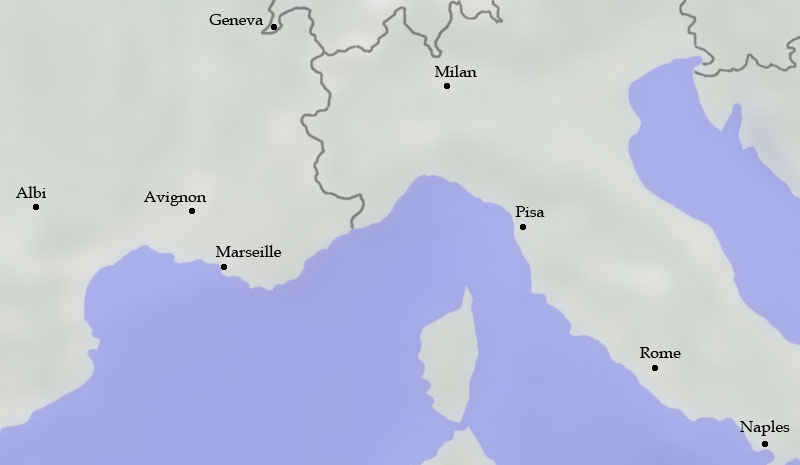


The Tarot of Ideals



The Geography of the Tarot’s Origins

Milan is the home of the Visconti family. The Visconti-Sforza cards are the oldest surviving Tarot cards, commissioned during the 1440’s by Filippo Maria Visconti, Duke of Milan.
From 1309 to 1377, Avignon was the home of the Catholic popes due to a conflict between the Papacy and the French crown. Pope Gegory XI returned the papacy to Rome; but after the election of his successor, Urban VI, the French cardinals elected a rival pope, Clement VII, who moved back to Avignon. His reign, and that of his successor, Benedict XIII, are now called the Western Schism, which effectively ended in 1417. (For a time, there was even a third pope, in Pisa.) See The Origin of Tarot cards by Jean Verame for links between the Tarot’s origins and Avignon. See also The Papesse for another possible link.
Albi gave its name to the Albigensian crusade of the thirteenth century, during which Pope Innocent III attempted to eliminate the gnostic Cathar sect from the south of France.
Tarot hypotheses
The Visconti-Sforza cards are the oldest surviving Tarot cards, but they were not the first Tarot cards ever made.
The first cards were a popular phenomenon, later idealized and carefully preserved in the expensive and elegant “designer” Visconti-Sforza cards.
The earliest popular cards, like most everyday household items of the time, have not survived.
The Visconti-Sforza cards were made in the 1440’s, so the original cards date from some time prior to that.
The great mass of Tarot cards, and the most consistent tradition, come from the south of France.
The Tarot of Marseille preserves the original Tarot tradition, even though they are not among the oldest physical cards in existence.
The Tarot as we know it originated in or around Avignon, the seat of the Catholic Popes from 1309 to 1377, and of rival Popes from 1378 to 1417.
The minor suit cards derived from the Mamluk playing cards from fourteenth century Egypt.
The trump cards were originally religious cards that embodied imagery from mystery, miracle, and morality plays, and allegorical literature, and were encouraged by the church.
The trump cards were added to the minor suit cards at some point to legitimize, or camouflage, playing cards, and the Tarot was born.
Best guess as to the time period of the genesis of the Tarot: the reign of Pope Clement VII, antipope in Avignon from 1378-1394.
Clement VII was supported by Queen Joan of Naples, who had sold Avignon to Pope Clement VI in 1348, and who is the contemporary referent of the Papesse card.